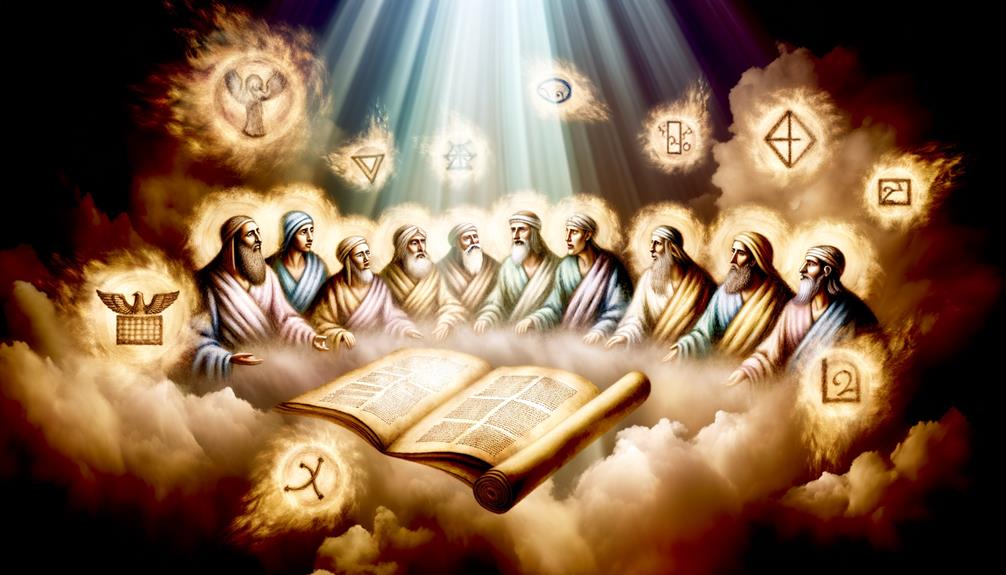God’s Glory Meaning in the Bible: Divine Majesty!
In the Bible, God’s glory (‘kavod’ in Hebrew and ‘doxa’ in Greek) signifies His profound honor, splendor, and majestic radiance. This concept encapsulates God’s visible manifestation and the intrinsic worth of His presence and character.
Theophanies in the Old Scriptures, such as the burning bush, and covenantal revelations with figures like Moses illustrate His immanence and transcendence. In the New Testament, Jesus Christ embodies divine glory, as seen in events like the Transfiguration and His resurrection.
Prophetic visions affirm God’s sovereign plans. Understanding God’s glory illuminates theological insights about divine presence, and invites further contemplation about its implications for believers.

Key Takeaways
- God’s glory signifies His divine presence, honor, and splendor, as seen in both the Old and New Testaments.
- The Hebrew term ‘Kavod’ and Greek term ‘Doxa’ capture the weightiness and radiance of God’s majesty.
- Jesus’ life, teachings, and miracles reveal the ultimate manifestation of God’s glory.
- Prophetic visions and apostolic teachings emphasize God’s glory as central to divine revelation and believers’ sanctification.
God’s Glory in the Bible: Understanding Its Meaning and Manifestation
| Aspect | Biblical Reference | Explanation |
|---|---|---|
| God’s Presence and Majesty | Exodus 24:17 | “The glory of the Lord looked like a consuming fire on top of the mountain.” God’s glory is often associated with His visible, overwhelming presence. |
| Manifestation of God’s Holiness | Isaiah 6:3 | “Holy, holy, holy is the Lord Almighty; the whole earth is full of His glory.” God’s glory reflects His perfect holiness and moral purity. |
| God’s Power and Sovereignty | Psalm 19:1 | “The heavens declare the glory of God; the skies proclaim the work of His hands.” God’s glory is revealed through creation, displaying His power and control. |
| Jesus as the Embodiment of God’s Glory | John 1:14 | “The Word became flesh and made his dwelling among us. We have seen his glory, the glory of the one and only Son.” Jesus Christ reflects the glory of God through His life and mission. |
| Glory Given to God by Believers | 1 Corinthians 10:31 | “So whether you eat or drink or whatever you do, do it all for the glory of God.” Believers are called to glorify God in all aspects of their lives, recognizing His greatness. |
| Eternal Glory in Heaven | Romans 8:18 | “The sufferings of this present time are not worth comparing with the glory that is to be revealed to us.” God’s glory will be fully revealed in eternity, and believers will share in it. |
Biblical Definitions

The concept of God’s glory in the Bible encompasses a rich tapestry of meanings that are intricately woven through various Hebrew and Greek terms, each contributing to a multifaceted theological understanding. The term “glory” often refers to the radiance and splendor of God as well as his honor and praise. It also conveys the idea of God’s presence and power, particularly in the context of his divine attributes and majestic sovereignty. Therefore, the biblical interpretation of Lord God‘s glory is integral to understanding his character and the nature of his relationship with humanity.
In Hebrew, the term ‘kavod’ denotes weightiness, honor, and splendor, reflecting a profound respect and reverence for God’s majestic presence.
Conversely, the Greek term ‘doxa’ often signifies brightness, radiance, and divine majesty.
These linguistic nuances underscore the complex nature of divine glory, encapsulating both the visible manifestation of God’s presence and the inherent worthiness of His character.
Consequently, biblical definitions of God’s glory serve as a foundational pillar for theological reflection, inviting believers to contemplate the profound mystery and reverence owed to the divine.
Old Testament Depictions

In the Old Scripture, God’s glory is depicted through a series of theophanies, covenantal revelations, and the sanctification of sacred spaces, each instance revealing facets of His majestic and transcendent nature.
Theophanies, such as the burning bush in Exodus 3, manifest God’s immediate presence, underscoring His power and holiness.
Covenantal revelations, like those to Abraham and Moses, encapsulate God’s commitment and sovereign will, making His glory evident through divine promises and law-giving.
Additionally, the sanctification of spaces, including the Tabernacle and Solomon’s Temple, symbolizes God’s dwelling among His people, marked by a palpable, sometimes overwhelming, presence.
These depictions collectively underscore a multifaceted understanding of God’s glory as both immanent and transcendent in biblical theology.
New Testament Revelations

In the New Testament, God’s glory is profoundly manifested through the divine radiance of Jesus Christ, particularly evident during pivotal events such as the Transfiguration.
The apostles’ witnessing of this glory serves as a critical witness, reinforcing the divine identity and mission of Jesus.
These revelations not only affirm the continuity of God’s glory from the Old Testament but also expand its comprehension within the framework of the new covenant.
Jesus’ Divine Radiance
Through the New Covenant, Jesus’ divine radiance is revealed with profound clarity, exemplifying His inherent deity and illuminating His role in the salvation of humankind. The New Scripture offers numerous accounts that underscore this divine radiance, portraying Jesus as the embodiment of divine light and truth. These revelations are pivotal for understanding His unique position within the Godhead and His mission on earth.
| Scripture Reference | Description of Divine Radiance |
|---|---|
| John 1:14 | The Word became flesh and dwelt among us, full of grace and truth. |
| Hebrews 1:3 | He is the radiance of God’s glory and the exact representation of His being. |
| Matthew 17:2 | Transfiguration: His face shone like the sun, and His clothes became white as light. |
| Revelation 1:16 | His face was like the sun shining in all its brilliance. |
| 2 Corinthians 4:6 | God’s light shines in our hearts to give us the knowledge of God’s glory displayed in Christ. |
Apostolic Witnessing of Glory
Frequently, the Apostolic witness in the New Scriptures provides compelling evidence of God’s glory as revealed through Jesus Christ, emphasizing both the transformative and revelatory nature of their encounters.
The apostles, through their firsthand experiences and testimonies, underscore the divine radiance manifested in Christ. Their accounts, rooted in lived experiences, offer theological and doctrinal insights into the nature of God’s glory.
Key elements include:
- Transfiguration: Peter, James, and John witness Jesus’ divine radiance (Matthew 17:1-8).
- Resurrection Appearances: Post-resurrection, Jesus’ appearances affirm His divine nature (John 20:19-29).
- Pentecost: The Holy Spirit’s descent empowers the apostles to proclaim God’s glory (Acts 2:1-4).
Prophetic Visions

In examining prophetic visions within the biblical context, one observes the intricate interplay between divine revelations and their symbolic representations.
These visions often encapsulate profound theological truths and are pivotal in illustrating the prophets’ direct encounters with God’s glory.
Analyzing these elements provides a deeper understanding of the narrative and theological significance of prophetic literature.
Divine Revelations Described
How do the prophetic visions detailed within the Bible serve as profound manifestations of divine revelations? These visions, often given to prophets, act as conduits through which God’s will, purpose, and glory are revealed to humanity. They are not merely foretellings of future events but are rich with theological significance and insight into divine nature.
These revelations provide:
- Clarity in understanding God’s intentions and plans for humanity.
- Assurance of God’s omnipotence and sovereignty over earthly and cosmic affairs.
- Guidance for moral and ethical decision-making, rooted in divine wisdom.
Thus, prophetic visions encapsulate the profound intersection of divine will and human history, revealing the grandeur of God’s glory.
Symbolism in Prophetic Visions
Prophetic visions in the Bible are replete with rich symbolism, serving as a profound medium through which complex theological truths are communicated.
These visions often employ vivid imagery—such as beasts, celestial bodies, and natural phenomena—to convey divine messages.
For instance, the vision of the dry bones in Ezekiel 37 symbolizes Israel’s spiritual revival. Similarly, Daniel’s visions use symbols like the ram and the goat to represent empires and historical shifts.
This symbolic language transcends literal interpretation, inviting deeper reflection and spiritual insight.
Through such symbolism, the biblical prophets articulate the majesty, sovereignty, and eschatological plans of God, thereby offering readers a glimpse into the divine narrative that shapes human history and destiny.
Prophets’ Encounters With God
Encountering the divine presence through prophetic visions profoundly shaped the theological and existential perspectives of biblical prophets. These encounters, often characterized by overwhelming displays of God’s glory, served to validate the prophets’ divine commission and message.
Prophetic visions provided a direct, unmediated experience of the divine, which had significant implications for the understanding of God’s nature and His relationship with humanity.
Key elements of these encounters include:
- Isaiah’s Vision: Isaiah 6 describes a vision of the Lord seated on a high and exalted throne, with seraphim in attendance.
- Ezekiel’s Vision: Ezekiel 1 narrates a complex vision of God’s glory, involving cherubim and a divine chariot.
- Daniel’s Vision: Daniel 7 features symbolic imagery of heavenly courts and divine judgment.
Jesus and God’s Glory

In examining the New Covenant, it becomes evident that Jesus embodies and reveals God’s glory through His life, teachings, and redemptive acts.
The Gospel of John explicitly identifies Jesus as the incarnate Word, who ‘became flesh and dwelt among us’ (John 1:14), manifesting divine glory. This glory is witnessed in His miraculous works, such as healing the sick and raising the dead, each act reflecting God’s benevolence and power.
In addition, Jesus’ sacrificial death and resurrection epitomize the ultimate revelation of God’s glory, demonstrating His love and justice.
The Transfiguration event, as recorded in the Synoptic Gospels, moreover accentuates this divine glory, wherein Jesus’ divine nature is visibly affirmed.
Consequently, Jesus serves as the quintessential revelation of God’s glory in the New Covenant.
Apostolic Teachings

Building upon the revelation of God’s glory in Jesus, the apostolic teachings further elucidate this divine attribute through their doctrinal expositions and pastoral instructions.
The apostles, in their epistles, weave a rich tapestry of theological insights that underscore the multifaceted nature of God’s glory. Their writings emphasize its manifestation in the life and work of Christ, its transformative power in believers, and its ultimate eschatological fulfillment.
- Christocentric Focus: Apostles highlight Jesus as the embodiment of God’s glory.
- Sanctification: They connect God’s glory with the process of sanctification in believers.
- Eschatology: Apostolic teachings envisage the full revelation of God’s glory at the end times.
This exegesis underscores the centrality of God’s glory in apostolic thought.
Implications for Believers

The apostolic teachings on God’s glory impart profound implications for believers, intricately linking divine revelation with the lived experiences of faith.
The manifestation of God’s glory, as elucidated in scriptures, serves both as a source of spiritual encouragement and as a moral imperative. Believers are called to reflect this divine glory through righteous living, thereby becoming visible representatives of God’s nature.
In addition, the transformative power of encountering God’s glory cultivates a deeper sense of purpose and sanctification. This theological concept not only underscores the transcendence and immanence of God but also provides a framework for understanding the Christian vocation.
Ultimately, the glory of God functions as both a beacon of hope and a guiding principle for ethical conduct in the believer’s journey.
Conclusion
Coincidentally, the multifaceted concept of God’s glory, as depicted in the Bible, reveals profound theological insights.
From the Old Scriptures’ majestic portrayals to the New Scriptures’ revelations and prophetic visions, the essence of divine splendor underscores God’s transcendence and immanence.
The teachings of Jesus and the apostles further illuminate this glory, offering a coherent narrative that impacts believers’ lives.
This thorough understanding invites deeper reflection on the divine nature and its implications for faith and practice.






